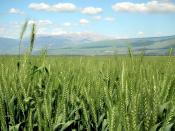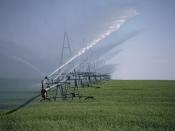The Green Revolution is, essentially, the effort to increase agricultural yields throughout the world and, more specifically, less developed countries. The Green Revolution began in 1945 when Norman Borlaug, a microbiologist and geneticist, with the help of CIMMYT, successfully bred a high yield variety (HYV) of wheat (Haberman, pars. 3-4). Although very controversial, the Green Revolution transformed farming through improvements such as high yield varieties (HYV's) of crops, genetically modified (GMO's) crops, and more resourceful methods of cultivation. With these agricultural developments came both overt challenges and successes. These successes, comprising of the mass production of crops, environmentally safe methods of farming, and innovative nutrient-rich products, have made it possible for a much larger portion of the world to enjoy a healthier and more regular diet.
During the mid 1960's and continuing throughout the 1970's, high yield varieties (HYV) of wheat and rice increased food production throughout the entire world.
Borlaug communicates:
"'In India, in 1965, 12.3 metric tons of wheat were produced under near ideal conditions. Last year' [1971] 'this had risen to 20 millions metric tons.' [While in] 'Pakistan, in 1965, the harvest was 4.6 million tons and last year' [1971] 'it had risen to 8.4 or almost double.'"(qtd. in Johnson 5).
India and Pakistan gained a greater agricultural output due to the introduction of HYV crops into their farming systems. These newly developed HYV crops, otherwise known as dwarf plants, were smaller in size and grew faster than regular wheat and rice. This aspect of dwarf plant growth was very effective, as the energy stimulated growth in the seeds rather than in the stalks ("Dwarf Plants," par.1), which are useless for human consumption. Thus, food production was greatly enhanced, causing a decrease in market price. Additionally, the low market price made this food source available to...


